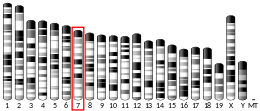ZFP36
ZFP36아연 핑거 단백질 36 호몰로그(ZFP36)로도 알려진 트리스테트라프롤린은 사람, 쥐, 쥐가 ZFP36 [5][6]유전자에 의해 암호화되는 단백질이다.낙산염 반응 인자 1 및 [7]2와 함께 TIS11(TPA 유도 배열) 패밀리의 구성원이다.
TTP는 일부 사이토카인의 mRNA의 3' 미번역 영역(UTR)에서 AU가 풍부한 원소(ARE)에 결합하고 분해를 촉진한다.예를 들어, TTP는 [8]mRNA를 불안정하게 함으로써 TNF-alpha 생성을 방해하는 네거티브 피드백 루프의 구성요소입니다.TTP가 부족한 생쥐는 염증성 [8]질환의 복합 증후군을 일으킨다.
상호 작용
ZFP36은 YWHAH와 [9]같은 14-3-3 단백질 패밀리 및 핵공 [10]복합체의 구성원인 NUP214와 상호작용하는 것으로 나타났다.
규정
전사 후 TTP는 여러 [7]가지 방법으로 규제됩니다.TTP의 세포하 국소화는 단백질의 14-3-3 계열과 같은 단백질 파트너와의 상호작용에 의해 영향을 받는다.이러한 상호작용과 표적 mRNA와의 상호작용은 단백질이 많은 단백질 [7]키나제에 의해 번역 후 변형될 수 있기 때문에 TTP의 인산화 상태에 의해 영향을 받는다.TTP 전사물이 miR-29a와 [7]같은 마이크로RNA의 표적이 될 수 있다는 증거가 있다.
레퍼런스
- ^ a b c GRCh38: 앙상블 릴리즈 89: ENSG00000128016 - 앙상블, 2017년 5월
- ^ a b c GRCm38: 앙상블 릴리즈 89: ENSMUSG000044786 - 앙상블, 2017년 5월
- ^ "Human PubMed Reference:". National Center for Biotechnology Information, U.S. National Library of Medicine.
- ^ "Mouse PubMed Reference:". National Center for Biotechnology Information, U.S. National Library of Medicine.
- ^ DuBois RN, McLane MW, Ryder K, Lau LF, Nathans D (Dec 1990). "A growth factor-inducible nuclear protein with a novel cysteine/histidine repetitive sequence". J Biol Chem. 265 (31): 19185–91. doi:10.1016/S0021-9258(17)30642-7. PMID 1699942.
- ^ "Entrez Gene: ZFP36 zinc finger protein 36, C3H type, homolog (mouse)".
- ^ a b c d Sanduja S, Blanco FF, Dixon DA (2011). "The roles of TTP and BRF proteins in regulated mRNA decay". Wiley Interdiscip Rev RNA. 2 (1): 42–57. doi:10.1002/wrna.28. PMC 3030256. PMID 21278925.
- ^ a b Carballo E, Lai WS, Blackshear PJ (August 1998). "Feedback inhibition of macrophage tumor necrosis factor-alpha production by tristetraprolin". Science. 281 (5379): 1001–5. doi:10.1126/science.281.5379.1001. PMID 9703499.
- ^ Johnson BA, Stehn JR, Yaffe MB, Blackwell TK (May 2002). "Cytoplasmic localization of tristetraprolin involves 14-3-3-dependent and -independent mechanisms". J. Biol. Chem. 277 (20): 18029–36. doi:10.1074/jbc.M110465200. PMID 11886850.
- ^ Carman JA, Nadler SG (March 2004). "Direct association of tristetraprolin with the nucleoporin CAN/Nup214". Biochem. Biophys. Res. Commun. 315 (2): 445–9. doi:10.1016/j.bbrc.2004.01.080. PMID 14766228.
추가 정보
- Blackshear PJ (2003). "Tristetraprolin and other CCCH tandem zinc-finger proteins in the regulation of mRNA turnover". Biochem. Soc. Trans. 30 (Pt 6): 945–52. doi:10.1042/bst0300945. PMID 12440952.
- Carrick DM, Lai WS, Blackshear PJ (2005). "The tandem CCCH zinc finger protein tristetraprolin and its relevance to cytokine mRNA turnover and arthritis". Arthritis Research & Therapy. 6 (6): 248–64. doi:10.1186/ar1441. PMC 1064869. PMID 15535838.
- Taylor GA, Lai WS, Oakey RJ, et al. (1991). "The human TTP protein: sequence, alignment with related proteins, and chromosomal localization of the mouse and human genes". Nucleic Acids Res. 19 (12): 3454. doi:10.1093/nar/19.12.3454. PMC 328350. PMID 2062660.
- Lai WS, Stumpo DJ, Blackshear PJ (1990). "Rapid insulin-stimulated accumulation of an mRNA encoding a proline-rich protein". J. Biol. Chem. 265 (27): 16556–63. doi:10.1016/S0021-9258(17)46259-4. PMID 2204625.
- Taylor GA, Thompson MJ, Lai WS, Blackshear PJ (1995). "Phosphorylation of tristetraprolin, a potential zinc finger transcription factor, by mitogen stimulation in intact cells and by mitogen-activated protein kinase in vitro". J. Biol. Chem. 270 (22): 13341–7. doi:10.1074/jbc.270.22.13341. PMID 7768935.
- Heximer SP, Forsdyke DR (1993). "A human putative lymphocyte G0/G1 switch gene homologous to a rodent gene encoding a zinc-binding potential transcription factor". DNA Cell Biol. 12 (1): 73–88. doi:10.1089/dna.1993.12.73. PMID 8422274.
- Huebner K, Druck T, LaForgia S, et al. (1993). "Chromosomal localization of four human zinc finger cDNAs". Hum. Genet. 91 (3): 217–22. doi:10.1007/BF00218259. PMID 8478004. S2CID 35926610.
- Lai WS, Carballo E, Thorn JM, et al. (2000). "Interactions of CCCH zinc finger proteins with mRNA. Binding of tristetraprolin-related zinc finger proteins to Au-rich elements and destabilization of mRNA". J. Biol. Chem. 275 (23): 17827–37. doi:10.1074/jbc.M001696200. PMID 10751406.
- Dintilhac A, Bernués J (2002). "HMGB1 interacts with many apparently unrelated proteins by recognizing short amino acid sequences". J. Biol. Chem. 277 (9): 7021–8. doi:10.1074/jbc.M108417200. PMID 11748221.
- Lai WS, Kennington EA, Blackshear PJ (2002). "Interactions of CCCH zinc finger proteins with mRNA: non-binding tristetraprolin mutants exert an inhibitory effect on degradation of AU-rich element-containing mRNAs". J. Biol. Chem. 277 (11): 9606–13. doi:10.1074/jbc.M110395200. PMID 11782475.
- Johnson BA, Stehn JR, Yaffe MB, Blackwell TK (2002). "Cytoplasmic localization of tristetraprolin involves 14-3-3-dependent and -independent mechanisms". J. Biol. Chem. 277 (20): 18029–36. doi:10.1074/jbc.M110465200. PMID 11886850.
- Brooks SA, Connolly JE, Diegel RJ, et al. (2002). "Analysis of the function, expression, and subcellular distribution of human tristetraprolin". Arthritis Rheum. 46 (5): 1362–70. doi:10.1002/art.10235. PMID 12115244.
- Strausberg RL, Feingold EA, Grouse LH, et al. (2003). "Generation and initial analysis of more than 15,000 full-length human and mouse cDNA sequences". Proc. Natl. Acad. Sci. U.S.A. 99 (26): 16899–903. doi:10.1073/pnas.242603899. PMC 139241. PMID 12477932.
- Amann BT, Worthington MT, Berg JM (2003). "A Cys3His zinc-binding domain from Nup475/tristetraprolin: a novel fold with a disklike structure". Biochemistry. 42 (1): 217–21. doi:10.1021/bi026988m. PMID 12515557.
- Yu H, Stasinopoulos S, Leedman P, Medcalf RL (2003). "Inherent instability of plasminogen activator inhibitor type 2 mRNA is regulated by tristetraprolin". J. Biol. Chem. 278 (16): 13912–8. doi:10.1074/jbc.M213027200. PMID 12578825.
- Sawaoka H, Dixon DA, Oates JA, Boutaud O (2003). "Tristetraprolin binds to the 3'-untranslated region of cyclooxygenase-2 mRNA. A polyadenylation variant in a cancer cell line lacks the binding site". J. Biol. Chem. 278 (16): 13928–35. doi:10.1074/jbc.M300016200. PMID 12578839.









